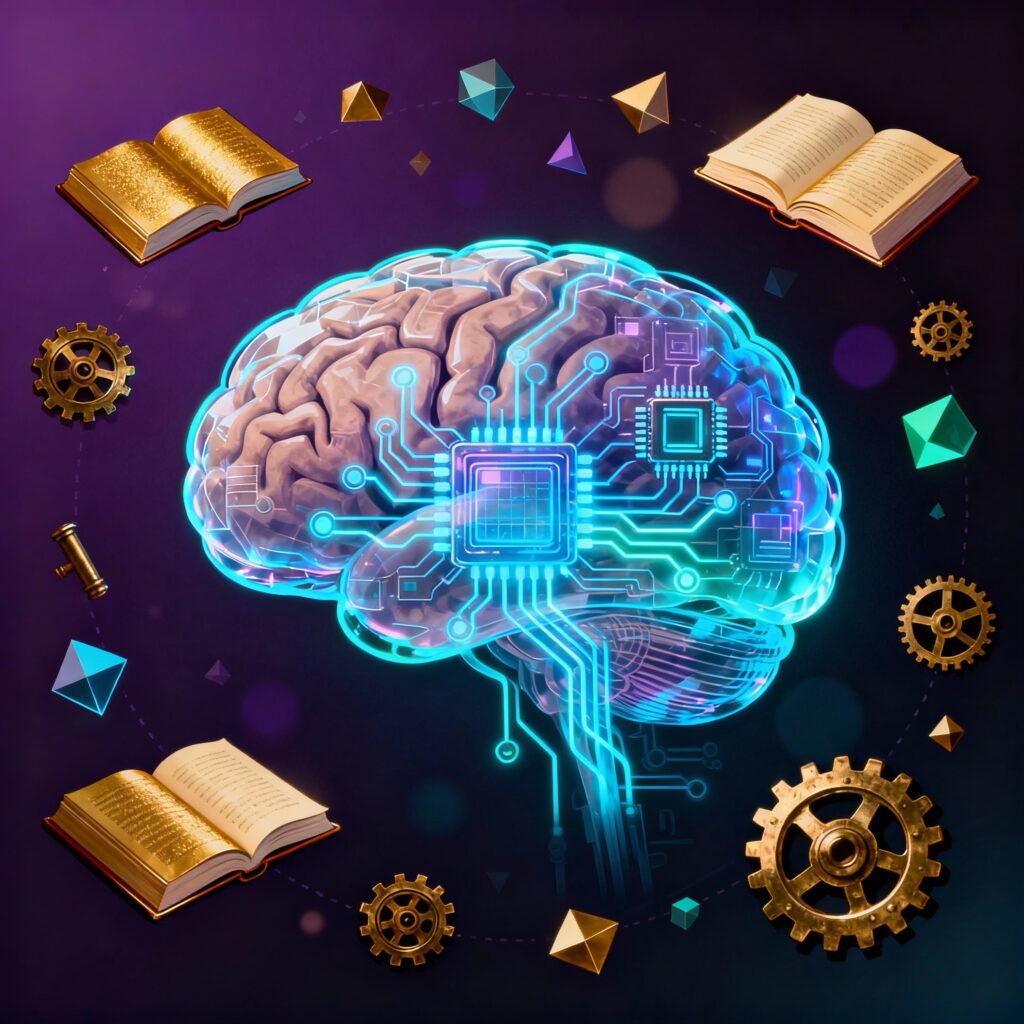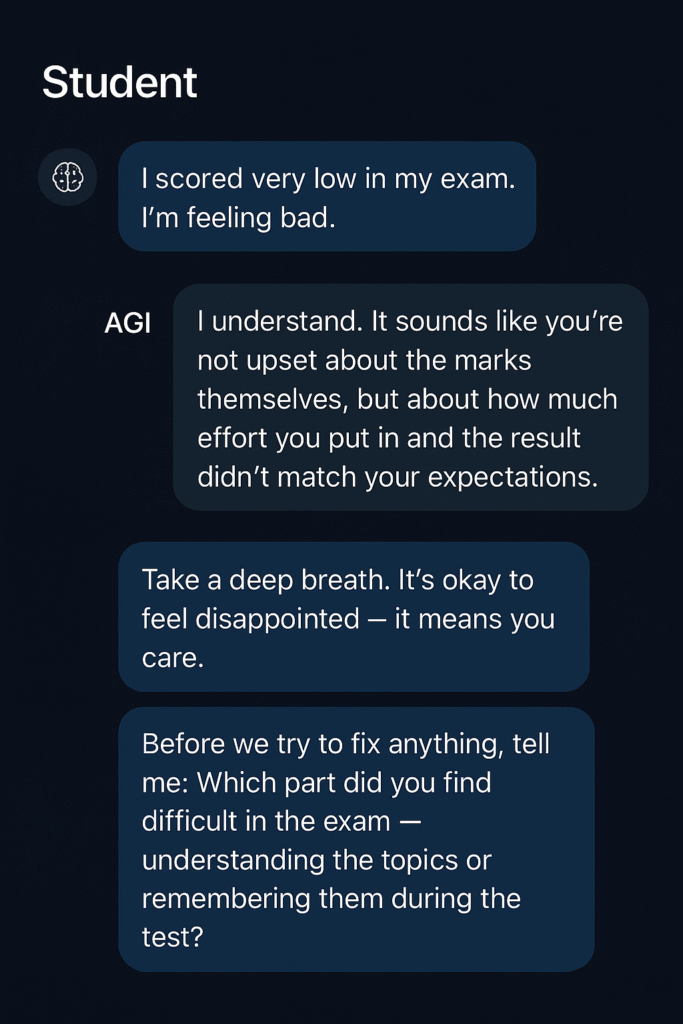AGI stands for Artificial General Intelligence. It is a very advanced level of Artificial Intelligence where a machine can understand, think, learn, and make decisions just like a human being without needing step-by-step instructions.
Right now, we are using the Narrow AI tools like ChatGPT, image generators, translation apps, or GPS navigation. This type of AI can do only one specific job:
- ChatGPT mainly processes and generates language
- Midjourney simply creates images
- And Google Maps give directions to us
Now, understand one thing: these AI tools don’t have common sense, self-understanding, or emotional awareness. They work only with the information they were trained on. But AGI is completely different.
Real-Life Story to Understand AGI vs Normal AI
Imagine there is a student named Rohan, and he is learning programming for the first time. One day, his teacher gave him a small task: create a simple calculator program.
Rohan tries again and again, but he cannot make it work correctly. After some time, he becomes frustrated and upset.
Now imagine Rohan’s best friend Amit is standing beside him, and Amit sees Rohan struggling, and jokingly says:
“Arre Rohan, you can’t even do this? Go jump into the lake!”
Did Amit really want Rohan to jump into the lake? No.
He only said that because:
- He was joking,
- He was trying to lighten the situation,
- And he knew Rohan understood emotions and tone.
So Rohan does not jump, because he understands the emotion, not just the words.
Now imagine if a Normal AI was in Rohan’s place
Normal AI like ChatGPT, Gemini, Copilot, etc., doesn’t understand emotions. It only understands the exact meaning of words.
So if someone says to a normal AI:
“Go jump into the lake,”
The AI might actually think, This is a command and I should follow it. Because it cannot understand jokes, sarcasm, human frustration, emotional tone, etc.
But AGI works differently
AGI understands context, emotion, and situation. If someone tells AGI:
“Go jump into the lake,”
AGI will pause and think:
- “The person is upset.”
- “The task didn’t work.”
- “This is an emotional reaction, not a real command.”
So, AGI says you “I understand you’re stressed. Let’s try the task again in a simpler way. I can help.”


How the Idea of AGI Started?
Scientists noticed that the human brain can handle many different tasks using the same thinking ability: We can learn, observe, understand emotions, create new ideas, adapt to new situations, and improve from mistakes.
For example: If a person moves to a new city, so he will learns a new language, or starts in new skill, they adjust with time. This ability is called General Intelligence.
Researchers and AI developers want to create a machine with this same level of flexibility, so a machine that doesn’t just follow commands, but actually understands situations and learns by itself.
The Goal of Artificial General Intelligence
The main goal is to build a machine that can do the following things:
- Think logically
- Understand context
- Learn new skills
- Adapt to new problems
- Work across different fields (like medicine, coding, business, music, etc.)
All of this with one single intelligence system refers to the human brain. If AGI faces a new problem it has never seen before, it will try to reason and find a solution, instead of writing for a programmer to update its code.

Advantages of AGI (Artificial General Intelligence)
AGI refers the multiple advantages that can change the world. Such as:
- Solving Complex Global Problems
- Smarter Decision-Making in Every Field
- Continuous Self-Learning
- Reducing Repetitive Work
1) Solving Complex Global Problems
AGI solves complex global problems because it can analyze huge amounts of data and understand patterns that humans cannot see. This means it can help to solve problems like:
- Climate change
- Agriculture optimization
- Energy management
- Medical research
For example, where a human scientist might take years of testing medicines, AGI can discover the same result in just a few minutes.
2) Smarter Decision-Making in Every Field
AGI can assist doctors, engineers, business leaders, farmers, teachers, and everyone. It won’t just give answers, it will understand the situation and suggest the most logical solution.
AGI can act like a master advisor, always ready to help. For example:
- A business owner getting accurate strategy recommendations
- A student receiving personalized learning guidance
3) Continuous Self-Learning
Narrow AI needs training again and again. But AGI will learn automatically from daily experiences and improve itself, same like humans do.
This means AGI can update itself, fix its own mistakes, and learn new concepts without reprogramming.
4) Reducing Repetitive Work
AGI can take over boring, time-consuming, repetitive tasks so humans can focus on creativity, strategy, innovation, and new ideas.
For example:
- Paperwork
- Data entry
- Scheduling
- Long-form research analysis
In simple words, human effort can shift from doing work to designing better ideas.
Disadvantages and Risks of Artificial General Intelligence
AGI is powerful, but it also comes with challenges. So it needs to be handled carefully and responsibly. Here are some important points that can affect humans, such as:
- Job Displacement Risk
- Ethical and Moral Concerns
- Dependency on Technology
- Possibility of Uncontrolled Behavior
1) Job Displacement Risk
AGI can perform many tasks faster and more accurately than humans. This means some jobs will disappear or change, especially in:
- Repetitive software jobs
- Basic data analysis roles
- Customer support roles
- Manual documentation and testing work
However, new jobs will also be created, especially in:
- AI management
- AI ethics
- Human-AI collaboration roles
- Creative and strategic fields
2) Ethical and Moral Concerns
AGI may face situations where decisions involve right and wrong, not just logic. For example, if a hospital has only one ventilator and two patients need it, who should get it?
Humans understand emotions, empathy, culture, values. So the machines need carefully designed moral frameworks to handle these situations.
3) Dependency on Technology
Whenever AGI becomes more capable, humans will start to depend too much on it. This could reduce the following points of humans:
- Problem-solving ability
- Mental sharpness
- Decision-making confidence
4) Possibility of Uncontrolled Behavior
If AGI becomes too powerful without proper safety rules, it might make decisions that are against humans.
This is why all major AI research companies develop:
- Safety guardrails
- Ethical alignment rules
- Human supervision systems
AGI Difference in Learning Style
Current AI depends on large amounts of data but AGI’s aim is to learn even when data is limited, by using logic, reasoning, and understanding, not just memory.
AGI will not just repeat known information. It will create new ideas, understand patterns, and recognize the meaning behind those patterns. AGI is also designed to understand human emotions and intentions.
For example: If someone speaks angrily because they are hurt or stressed, AGI should understand the emotional context, not just the words.

Where Are We Today In AGI Development?
AGI is still in development. Companies like OpenAI, Google DeepMind, Meta, Anthropic, and many research labs are working on it.
Every year, AI models are becoming more powerful, and this progress is slowly moving toward AGI.
Many scientists believe that AGI may start appearing between 2030 and 2040, though some say early forms of AGI may already be emerging in research labs.
Also Learn Other Topics
- An Introduction of Artificial Intelligence
- How can we use AI for Python?
- How can we write our first AI program?
- Learn AI search techniques
Normal AI is like a specialist; one AI can translate languages, another can generate images, and another can play chess. AGI is like a human learner; it can understand new concepts, learn new skills by itself, and apply knowledge across different tasks.

M.Sc. (Information Technology). I explain AI, AGI, Programming and future technologies in simple language. Founder of BoxOfLearn.com.
